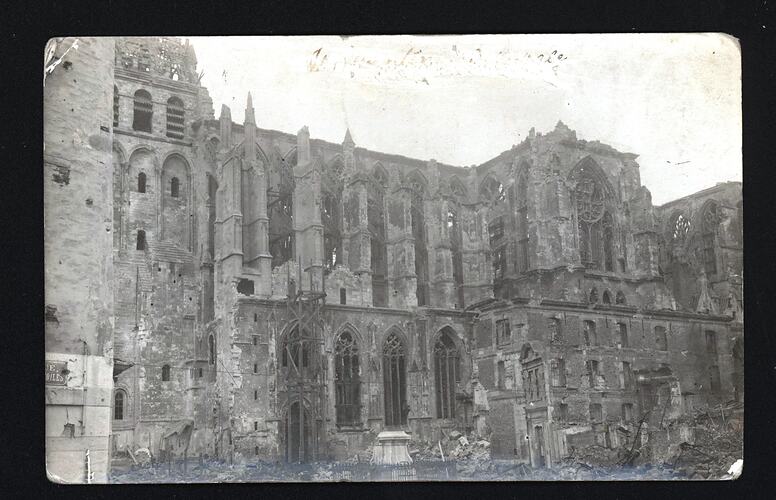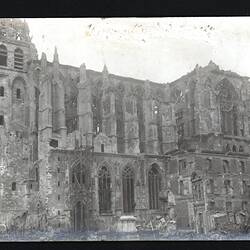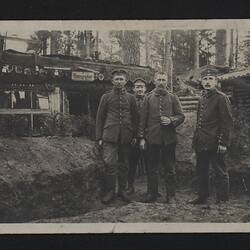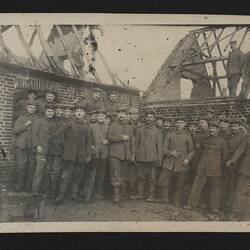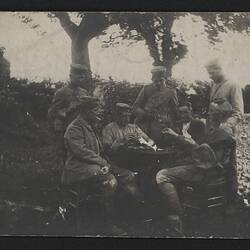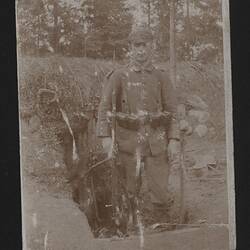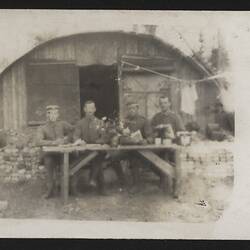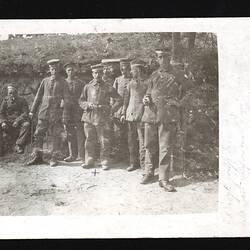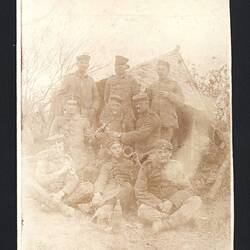Summary
Postcard depicting a heavily damaged cathedral, probably in France or Belgium. A hand-written inscription on the front has been scratched out - probably was name of cathedral. It is likely to have been removed by censors.
The postcard is inscribed with the date 3 July 1918. Its provenance is unknown.
Description of Content
Photograph of a damaged cathedral. Its roof is missing. its windows have been largely blown out, and its brickwork is heavily damaged.
Physical Description
Black and white photographic print - now sepia appearance. No border. Printed with lines indicative of postcard (very faint).
Significance
One of a group of photographs and postcards that document the experience of German soldiers during World War I. Although the group has no provenance, the images show a human side to soldiers of the Central Powers. Pictures by or of World War I German soldiers are relatively rare in Australian museums. These are particularly significant as they were apparently taken by German soldiers, showing them engaged in everyday activities.
The images chronicle German soldiers' wartime experience, from serving with Armeegruppe Schaffer in Romania up until the Romanian surrender in 1917. The group includes an image of a war-damaged French church/cathedral, probably taken after the Germans were moved from the Eastern to the Western front. Of particular interest is the image of celebrating German troops in Romania - documenting a victory that was to be short-lived for the Germans.
Further research - including translation of the German hand-written texts - will shed more light on the significance of these photographs and postcards.
More Information
-
Collecting Areas
-
Acquisition Information
Donation from Mr David Crotty - Museum Victoria, 30 Jun 2011
-
Place & Date Depicted
France, 3 Jul 1918
Possible location of image. -
Place & Date Depicted
Belgium, 3 Jul 1918
Possible location of image. -
Other Association (See Comments)
Germany
Origin of soldiers depicted. -
Format
Postcard, 5½ in. x 3½ in., Black & White
-
Inscriptions
A hand-written inscription on the front has been scratched out (probably was name of cathedral). On reverse: '3.7.18 / Lieber Max! / War gerade überm(?) Briefe schreiben, / da kam noch Dein [illegible]brief vom / 28.6. an. Besten Dank. / Liegen(?) immer noch in der [illegible] , / hoffen aber bald fort zu kommen! / Nach grosser Bullenhitze ist es heute / wieder(?) [illegible] und unfreundlich / geworden. Kann den Pelzmantel / wieder gebrauchen. / Von [illegible] bekam ich auch Nachricht, es / scheint ihm in der(?) [illegible] gut gefallen zu haben. Mit Urlaub werde(?) ich noch 6 Wochen warten müssen / Mitte August also. Bei Dir ist es / doch auch bald wieder Zeit / Womöglich(?) treffen wir uns im / schönen [illegible]. / Bei vollster Gesundheit grüßt / dich herzlich Hans' Translation: 'Dear Max! / I was just writing the letters, / as your [illegible]letter dated / from 28.6. arrived. Many thanks. / We are still lying in the [illegible] / but we are hoping to get away from here soon! / After a real scorcher [i.e. big sweltering heat] / it became again [illegible] and unfriendly / today. I need to use / the fur coat again. / I received message from [illegible], too, / it seems that he liked / it in [illegible]. I probably / have to wait for holidays another 6 weeks, / mid August then. For you / it is also soon time. [i.e. Isn't it time for you soon as well?] / If possible we will meet each other / in beautiful [illegible]. / In best health, I am greeting / you most warmly, Hans'.
-
Classification
-
Category
-
Discipline
-
Type of item
-
Overall Dimensions
140 mm (Width), 89 mm (Height)
-
Keywords
Cathedrals, Soldiers, World War I, 1914-1918, Military Censorship
